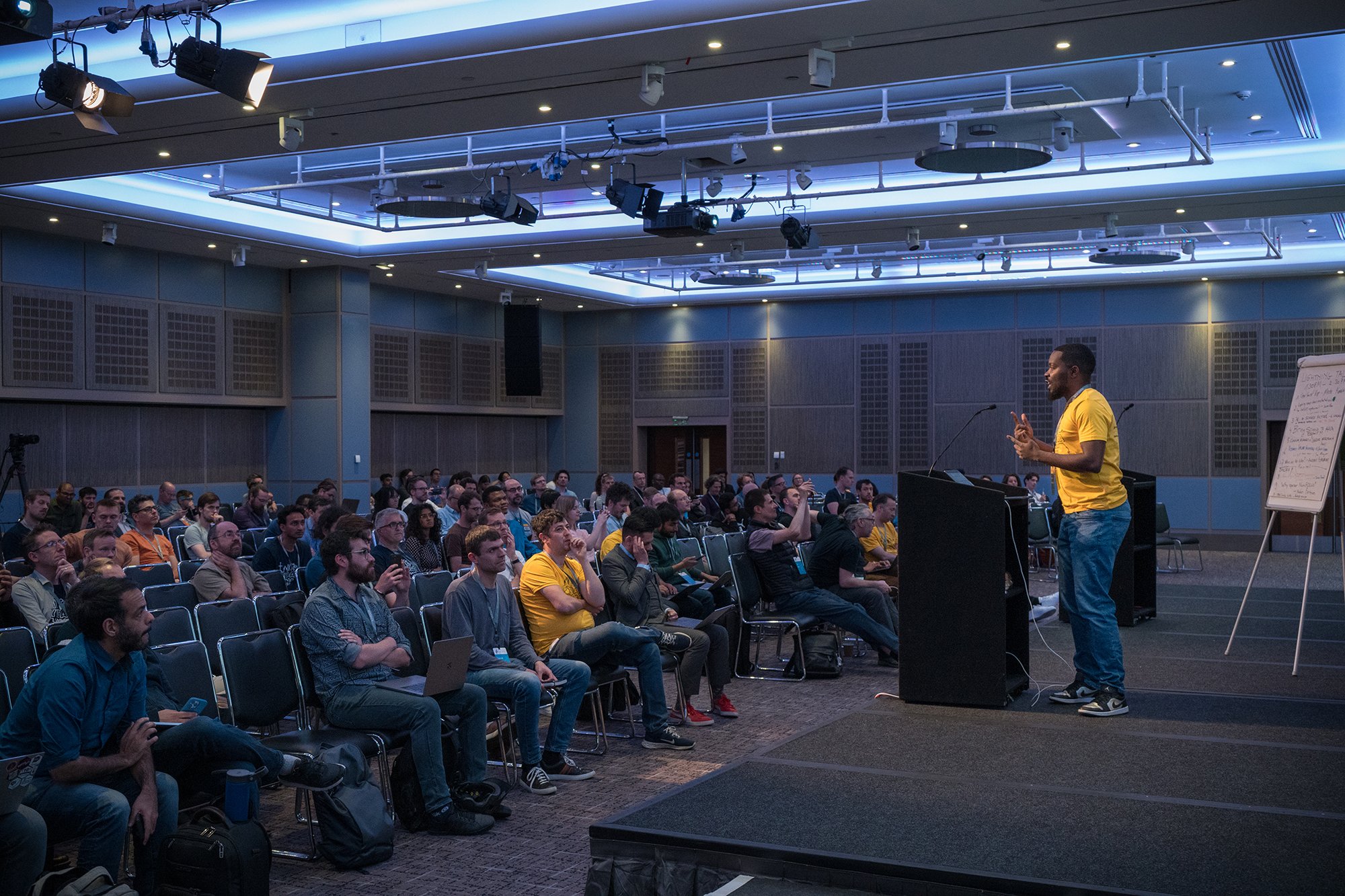
Call for Proposals
PyData London will be a three-day in-person event with live talks, keynote speakers, and community events.
Speakers will receive a free ticket to the entire event. All presentations will be given live and in-person.
Please note that speakers are asked to provide their own travel and lodging accommodations.
We look forward to reading your proposal and appreciate you being a part of the community!
Call for Proposal Deadline: February 24, 2025
Conference Dates: June 6-8, 2025
Tutorials: Friday, June 6
Talks: Saturday-Sunday, June 7-8

Proposal Guidelines
PyData London will be a three-day event with live Talks, and Tutorials. Speakers will give their presentations live.
The proposal selection process is double-blind, meaning that reviewers will not be able to see your name or other identifying information. Reviewers will see the proposal Title, Prior Knowledge Expected, Brief Summary, Bullet Point Outline, and Description, specialized track, and keywords. Please withhold identifying information from those fields.
Speakers will receive a free ticket to the entire event. All presentations will be given live and in-person.
Please note that speakers are asked to provide their own travel and lodging accommodations.
Thank you so much for considering submitting to PyData London 2025. We appreciate you being a part of the community!
Talks
Talks are 40-minute sessions including time for Q&A. A talk proposal is a short description of a talk that is aiming to convince someone to part with 30 minutes of their time, in order to learn about something. A good proposal should disclose:
The topic (the WHAT) and WHY it is interesting
The audience to WHOM the talk is addressed
The TYPE of talk (lots of maths, hands-on, etc) and possibly the tone (light-hearted, informative etc)
The TAKEAWAY, a.k.a. what will I learn
There are two parts to a proposal:
Brief Summary – This informs attendees what the talk is about. Discloses the topic, domain and overall purpose. This is at most a few lines long, and will be printed in the conference programme.
Description – This is a self-contained statement that summarises the aspects of the talk. It should be structured and present the objective of the talk, its outline, central thesis and key takeaways. After reading the description, the audience should have an idea of the overall presentation and know what to expect. The description should also make clear what background knowledge is expected from the attendees. Both this and the summary will be included in the talk details online.
While there is no strict template for this, you should make sure that the audience can understand why your talk is relevant for them.
Tutorials
Tutorials are 90 minute hands-on sessions where you have the opportunity to lead a classroom session so attendees can learn about a new skill/library/technology in a self-contained way, and have materials available to students before-hand so they can follow suit. Guidelines for the tutorial proposal are the same as above, but the description should make clear what are the requirements for the class and how the materials are going to be distributed (e.g. github repo, links, etc).
Tips on How to Write a Successful Proposal
A proposal serves two purposes: 1) convince the Program Committee to accept your proposal, and 2) act as the description of the talk/tutorial on the schedule. If accepted, you will have the opportunity to further edit and clarify the proposal ahead of the schedule’s publication.
The guidelines for proposing a talk versus a tutorial are essentially the same.
Good proposals include:
The topic and why it’s interesting
The audience that will benefit from attending this talk/tutorial
The takeaway for the audience
Any background knowledge needed to understand the talk/tutorial
Approximate time breakdowns of how the material will be covered, e.g. minutes 0-10: X1, minutes 10-15: Y1, etc.
There are two parts to a proposal:
Abstract: The abstract tells attendees what the talk/tutorial is about. It should answer all of the above questions, but it should remain short and to-the-point. This is your chance to pitch attendees on watching your talk/tutorial. If you are submitting a tutorial proposal, the abstract should also specify the requirements for participating and how materials will be distributed (e.g. Github repo, links, etc). If your materials are already hosted publicly somewhere, you can include the link.
Description: The description expands on the abstract and provides background and additional details about your talk/tutorial. It is often helpful for talk descriptions to include an outline of the talk/tutorial. The Program Committee reads each description carefully to determine if a talk/tutorial is a good fit. This is your chance to pitch the Program Committee on accepting your talk/tutorial. The Program Committee does occasionally ask for more information after proposals have been submitted, but it’s better to include relevant details up front and try to anticipate what questions the Committee will have after reading your proposal. For example, if you think the Committee may think you’re trying to cover too much ground, an outline with time estimates could help alleviate that concern.
Additional Talk/Tutorial Proposal Suggestions
Who is your target audience? Think about your target audience in terms of job role (data scientist, engineer, researcher, etc.) and experience level. Being clear about who you are speaking to (and the background knowledge you can expect them to have) is helpful both to you as you prepare your presentation, as well as to the audience considering whether your presentation is a good fit for them to attend.
Clear title: A catchy title can be useful, but don’t overdo it. People should get a rough idea of what your presentation is about just by reading the title. Your proposal and your presentation should be consistent with your title.
Get feedback: Ask friends and colleagues to review your abstract; bonus points if they are your target audience. Take time to tweak your abstract if needed. Additionally, if you are a first-time speaker, please indicate this in your proposal and we will reach out with more information regarding mentorship opportunities.
Common Pitfalls
Here are some common pitfalls that could lead to the proposal not being understood or rejected by the Program Committee:
Overly long proposals: Keep it simple and clear. Good proposals typically provide all the important information within 200 words. This is not a strict limit, just a suggestion to help you stay focused.
Future work: While talking about future work is interesting and could be mentioned in your talk, the core content of the talk should already be shaped, and you should be able to describe it in your proposal. Don’t rely too heavily on future data collection or future prototyping, because things often don’t go as expected.
Sales pitches: We are a community of creators and users of open-source scientific computing tools. You can reference your closed-source product or platform, but the audience will find the talk more interesting if they can try your techniques with the open source PyData stack. Your problem definition, proposed techniques, and business domain are also interesting, but sales pitches are typically rejected.
Repeated talks: We have a strong preference for new talks, and new speakers. If your talk is already available online, it is unlikely to be accepted for the conference.
